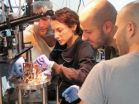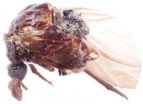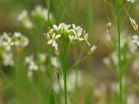(Press-News.org) A new theory of how cancer works could lead to the next generation of treatments of the disease.
The theory suggests that cancer forms when recently evolved genes are damaged, and cells have to revert to using older, inappropriate genetic pathways.
Astrobiologists Dr Charley Lineweaver from The Australian National University and Professor Paul Davies from Arizona State University teamed up with oncologist Dr Mark Vincent from the University of Western Ontario to develop the new model.
"The rapid proliferation of cancer cells is an ancient, default capability that became regulated during the evolution of multicellularity about a billion years ago," says Dr Lineweaver.
"Our model suggests that cancer progression is the accumulation of damage to the more recently acquired genes. Without the regulation of these recent genes, cell physiology reverts to earlier programs, such as unregulated cell proliferation."
In 2012 about 14.1 million new cases of cancer occurred globally, yet an underlying cause of the many forms of the disease has not yet been identified. To understand the disease better the team turned to the wealth of knowledge being revealed in the genome sequences from a large range of our distant relatives, including fish, corals and sponges.
This new knowledge has allowed scientists to establish the order in which genes evolved and is the basis of the new therapeutic implications of the model, said Dr Lineweaver.
"The adaptive immune system that humans have has evolved relatively recently, and it seems cancer cells do not have the ability to talk to and be protected by it. The new therapeutic strategies we are proposing target these weaknesses," he said.
"These strategies are very different from current therapies, which attack cancer's strength – its ability to proliferate rapidly."
Professor Davies says the new model will not provide an overnight cure.
"It is a work in progress but we think it gives a more consistent interpretation of what is currently known about cancer than other models do," he said.
Dr Lineweaver says that his research in astrobiology led him to look at cancer.
"Paul and I have always been interested in trying to answer big questions. This led us to astrobiology and trying to answer the question 'Are we alone?' To answer that, you need to know about how life got started and evolved on this planet, and that involves understanding the evolution of multicellularity. That is an obviously missing piece from our current models of cancer."
A video summary of the research is available at http://www.youtube.com/user/WBLifeSciences
INFORMATION:
New theory turns cancer on its head
2014-07-14
ELSE PRESS RELEASES FROM THIS DATE:
3D printed anatomy to mark a new era for medical training
2014-07-14
The creators of a unique kit containing anatomical body parts produced by 3D printing say it will revolutionise medical education and training, especially in countries where cadaver use is problematical.
The '3D Printed Anatomy Series', developed by experts from Monash University, is thought to be the first commercially available resource of its kind. The kit contains no human tissue, yet it provides all the major parts of the body required to teach anatomy of the limbs, chest, abdomen, head and neck.
Professor Paul McMenamin, Director of the University's Centre for ...
Physical fitness associated with less pronounced effect of sedentary behavior
2014-07-14
ATLANTA – July 14, 2014 –Physical fitness may buffer some of the adverse health effects of too much sitting, according to a new study by researchers from the American Cancer Society, The Cooper Institute, and the University of Texas. The study appears in the journal Mayo Clinic Proceedings, and finds the association between prolonged sedentary time and obesity and blood markers associated with cardiovascular disease is markedly less pronounced when taking fitness into account.
Sedentary behavior has been linked to an increase risk of obesity, metabolic syndrome, type ...
Domestication syndrome: White patches, baby faces and tameness
2014-07-14
More than 140 years ago, Charles Darwin noticed something peculiar about domesticated mammals. Compared to their wild ancestors, domestic species are more tame, and they also tend to display a suite of other characteristic features, including floppier ears, patches of white fur, and more juvenile faces with smaller jaws. Since Darwin's observations, the explanation for this pattern has proved elusive, but now, in a Perspectives article published in the journal GENETICS, a new hypothesis has been proposed that could explain why breeding for tameness causes changes in such ...
UEA research reveals how cannabis compound could slow tumour growth
2014-07-14
Scientists at the University of East Anglia have shown how the main psychoactive ingredient in cannabis could reduce tumor growth in cancer patients.
Research published today reveals the existence of previously unknown signaling platforms which are responsible for the drug's success in shrinking tumours.
It is hoped that the findings could help develop a synthetic equivalent with anti-cancer properties.
The research was co-led with the Universidad Complutense de Madridin, Spain. The team used samples of human breast cancer cells to induce tumours in mice. They ...
The world's first photonic router
2014-07-14
Weizmann Institute scientists have demonstrated for the first time a photonic router – a quantum device based on a single atom that enables routing of single photons by single photons. This achievement, as reported in Science magazine, is another step toward overcoming the difficulties in building quantum computers.
At the core of the device is an atom that can switch between two states. The state is set just by sending a single particle of light – or photon – from the right or the left via an optical fiber. The atom, in response, then reflects or transmits the next incoming ...
Serendipity at the Smithsonian: The 107-year journey of the beetle Rhipidocyrtus muiri
2014-07-14
Serendipity leads University of Kansas scientists to the discovery and description of Rhipidocyrtus muiri - a 107 year old, lost in collections specimen, which turned out to represent a new genus and species. The long and tortuous history of the enigmatic ripidiine wedge beetle from Borneo is discussed in a recent paper published in the open access journal ZooKeys.
The holotype male, and only known specimen of Rhipidocyrtus muiri, was collected 107 years ago in Borneo but subsequent to this it was transferred among several researchers in the early 1900s. The specimen ...
Best for bees to be stay-at-homes
2014-07-14
Honey bees with roots in the local environment manage much better in the struggle for survival than imported honey bees from foreign environments.
A world without bees would be a whole lot poorer – literally. In Denmark alone an additional 600 million to 1 billion Danish kroner are earned annually due to the work done by bees making honey and pollinating a wide range of crops from apples to cherries and clover.
Unfortunately, bees all over the world are under pressure from pesticides, mites, viruses, bacteria, fungi and environmental changes, among other things. The ...
Molecular mechanisms underlying the prevention of autoim-munity by Roquin revealed
2014-07-14
The Roquin protein, discovered in 2005, controls T-cell activation and differentiation by regulating the expression of certain mRNAs. In doing so, it helps to guarantee immunological tolerance and prevents immune responses against the body's own structures that can lead to autoimmune disease. Roquin is thus an immune regulator. Autoimmune diseases affect between five and ten per cent of the population. They usually occur as a result of complex environmental influences when a genetic predisposition exists. Only in rare cases the development of the disease is determined by ...
Flower development in 3D: Timing is the key
2014-07-14
In close collaboration with Jürg Schönenberger and Yannick Städler from the Department of Botany and Biodiversity Research of the Faculty of Life Sciences, University of Vienna, 14 developmental stages of the flower of Arabidopsis thaliana from very early meristematic floral initiation to fully developed seeds were monitored with micro-computed tomography in 3D. From the same set of developmental stages a full metabolic profile using mass spectrometry was measured covering hundreds of biochemical pathways.
"Smallest changes in floral organ development were thus correlated ...
A-maize-ing double life of a genome
2014-07-14
Early maize farmers selected for genes that improved the harvesting of sunlight, a new detailed study of how plants use 'doubles' of their genomes reveals. The findings could help current efforts to improve existing crop varieties.
Oxford University researchers captured a 'genetic snapshot' of maize as it existed 10 million years ago when the plant made a double of its genome – a 'whole genome duplication' event. They then traced how maize evolved to use these 'copied' genes to cope with the pressures of domestication, which began around 12,000 years ago. They discovered ...




